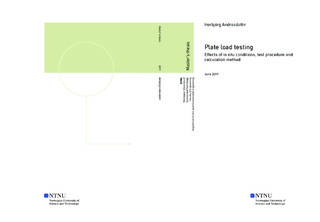| dc.description.abstract | The plate load test is a widely used and important test method to determine the bearing capacity of unbound granular materials in the superstructure of a road. The test is based in Boussinesq’s formula, which makes general assumptions that are not reasonable when considering the materials used for road construction. The test is thus very dependent on the test procedures, as well as the conditions in the field. The Norwegian Public Roads Administration has defined the plate load test as the only method for final documentation of the quality of compaction of unbound materials, and has defined a set of requirements that every measured point must fulfil. However, a number of contractors have experienced unexplained difficulties with fulfilling the requirements, even after repeated compaction efforts.
This thesis aims to assess to what extent the in-situ condition of the road, the superstructure materials and their in-situ state, as well as the test procedure and calculation method affect the results of the plate load tests. In order to answer the research questions, a document analysis, a case study and a field test were conducted. In the document analysis, national standards and regulations regarding requirements and test procedures for plate load tests from Norway, Sweden, Iceland and Germany were analysed and compared. The case study compared four different road construction sites; (1) a tunnel based project, (2) an urban road project, (3) a new motorway project and (4) a motorway upgrading project, by conducting semi-structured interviews on representatives from the constructor and/or owner builder, collecting measured results from plate load tests conducted on the site, and conducting observations in the field. Additional interviews with individuals with experience from multiple different construction sites, as well as results from plate load test measurements from additional sites were also considered, although not used for direct comparison in the case study. Finally, a field test was conducted using two different test procedures (from R211 and DIN 18134), two different plate sizes (diameter 300 mm and 600 mm), tested on three different levels in the superstructure (frost protection layer, subbase layer and interlocking layer).
The measurements from all plate load tests were processed using three different calculation methods; one based on DIN 18134, another according to R211, and a modified version based on R211. Most of the interviewees agreed that the in-situ factors that seem to have the most influence on the plate load test results are the moistures content of the superstructure materials, the time between compaction and testing, as well as the use of crushed asphalt and/or insulation materials in the superstructure. These claims need to be verified by further testing, but they provide a good reference point as to which factors to focus on. The results of the field test measurements suggest that the use of an interlocking material on top of the subbase material significantly increases the calculated E-values from the plate load tests. Other comparisons were inconclusive, likely due to the limited number of comparable measurements. Measurements conducted on site 2 were significantly lower than those conducted at site 4, potentially due to the large grain sizeof the subbase material at site 2, although this has to be investigated further.
Measurements conducted on superstructures containing insulation materials on site 4 were also significantly lower than measurements without insulation materials, although the effect of using different test procedures in this case must be assessed. The comparison between the results of different test procedures and calculation methods showed significant differences for some but not all cases, and the factors influencing these test results must therefore be investigated further. | nb_NO |

